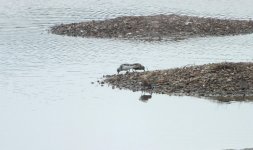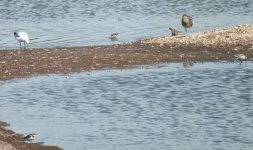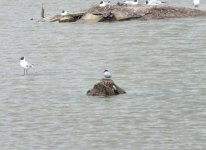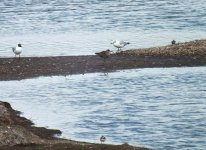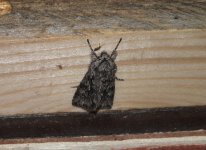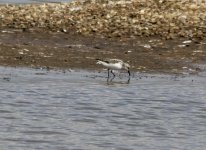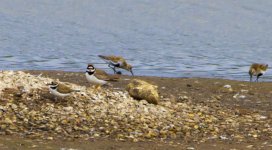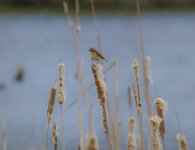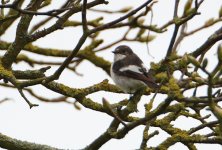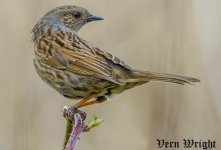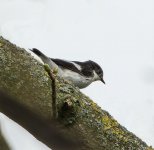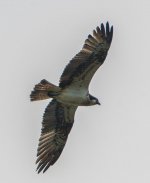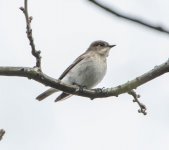Arrived just after 7.30am this morning the weather a little overcast but mild and even before I could get my camera and bins out I managed to see a Whitethroat on the sailing club car park, where I decided to head straight to the flashes and do the Sailing pool count a little later.
At the Flashes (tower hide) I was surprised to see no one was tier but hey what a day they missed the Black Tailed Godwits were in and out for a few hours (think this could have been due to a Kestrel showing interest in them) , a Green Sandpiper never returned after the first fly by from the kestrel and then the Sanderling arrived (08.55) a wonderful bird after a few minutes it left heading back towards the Moors but did return after around 10 minutes this time to be joined by a Dunlin.
After doing my counts I had noticed a few smaller birds moving around the Islands a White Wagtail and 3 Little Ringed Plovers which were moving from Island to Island at pace this morning didn’t seem to settle at all.
Only managed to see one Lapwing I would have thought they may have returned by now but here’s still hoping did notice many insects around and just before I left the hide a few Swallows and Sand Martins were flying across the pool.
Heading back towards the Sailing pool I managed to see a few Warblers mainly Willow and Sedge with quite a few Chiffchaff at the entrance to the Flashes counts and full list will follow at end of this little ditto.
Sailing Pool was a nice surprise today 3 Common Sandpiper were the highlight until (a lifer for me) the Artic Tern turned up in the afternoon plenty of Whitethroat and Blackcaps around the entrance to the flashes on the sailing pool side today.
Onto the Salwarpe walk through now and what a change from my last visit this place was alive Blackcaps, Chiffchaffs, wrens, finches and for a change butterflies – Peacock, Brimstone, Orange tip, Small White, small blue also ladybirds both red & black bodied.
As for insects they were everywhere looks like being another busy one in this wonderful little area again this year.
Now for the Moors not quite as lively bird species wise as the Flashes but did manage a lifer with the Whinchat also heard the Grasshopper Warbler & Cetti’s Warbler but didn’t connect with the camera, did have 2 Common Sandpiper drop in around 1pm (I wonder if these were the guys moving around on the flashes earlier).
It was great to see that Spring was actually arriving with many trees and bushes now showing signs of budding and the reeds actually turning green again round the North moors there were even Forget Me Not’s in flower also just around by lifestyles
I would like to thank everyone for their help today and especially to the gentleman with the scope in the new hide (on the moors) for letting me look through to see the whinchat.
TODAYS COUNTS –
FLASHES POOLS (7.55am) –
Blackbird, Robin, Willow Warbler, Sedge Warbler, Blue tit, Linnet, Great tit, Reed bunting, Song thrush, Mallard (14), Coot (11), Moorhen (5), Magpie, Wood pigeon, Shelduck (2), Black headed gull (250+), Tufted duck (4), Little ringed plover (3), Black tailed godwit (5), Lesser black backed gull (3), Avocet (25), White wagtail, Sanderlin (1), Dunlin (1), Mute swan (2), Canada goose (5), Green sandpiper (1), Bullfinch, Goldfinch, Dunnock, Oystercatcher (1), Swallow, Grey heron, Carrion crow, Blackcap, Chiffchaff, Sand martin
SAILING POOL (10.10) –
Great crested grebe (7), Mallard (6), Canada goose (7), Coot (2), Whitethroat, Blackcap, Chiffchaff, Common Sandpiper (3), Black headed gull (14), Blackbird, Robin, Swallow (7), Sand martin (3) got these counts as they rested on the wires just by the outdoor barbi, Artic tern (later in the day)
MOORS POOLS (11.20) –
Robin, Wood pigeon, Blackcap, Blackbird, Long tailed tit, Wren, Great tit, Common sandpiper (2),Mallard (11), Canada goose (23), Moorhen (9), Lesser black backed gull (6), Black headed gull (140+), Tufted duck (37), Blue tit, Reed bunting, Magpie, Bullfinch, Whinchat, Dunnock, Pheasant, Kestrel, Peregrine falcon, Shoveler (2 pairs), Lapwing (1), Teal (1 pair), Coot (36), Shelduck (2), Oystercatcher (2 pairs), Little grebe (2), Great crested grebe (4), Kingfisher, Gadwall (1pair), Cormorant (5), Cetti’s warbler (heard), Carrion crow, Chaffinch, Greenfinch, Jay, Grasshopper warbler (heard), Buzzard




